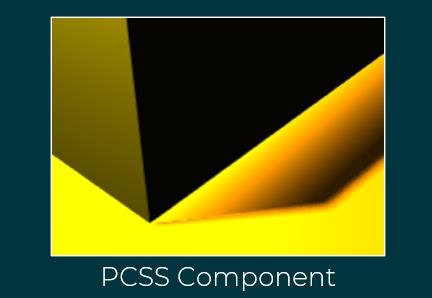
Ray-Tracing Shadow Map Hybrid shadow
A Hybrid approach to real-time soft shadow rendering
The Algorithm
is based on a GDC presentation by Jon Story from Nvidia in 2005.
Traditional approaches to soft shadow generation include Shadow mapping and Ray Tracing.
Shadow mapping is a well-established approach and can produce believable soft shadows with techniques like PCSS. However, Shadow mapping produces many visual artifacts under certain light configurations, like shadow acne(shadow banding), and peter-panning(which is a by-product of trying to solve shadow acne). While there are ways like dynamic bias and backface culling that can alleviate the effects, they are not always applicable or only works to an extent.
Ray Tracing, on the other hand, can render shadow accurately. While performance is decent for rendering hard shadows, it can suffer when we try to render soft shadows which require much more rays to be cast.
Our approach combines the benefits of both approaches, by using shadow mapping to render soft shadows and using ray-traced hard shadows to “patch up“ the missing part caused by Peter-panning.
My main contributions:
Research the topic, draft up the proposal, and formulate a presentation and research paper.
Implement shadow mapping, PCF soft shadow technique, Vogel Disk Sampling, Dynamic Bias, and PCSS soft shadow Technique in GLSL.
Soft shadow
What is soft shadow?
-Shadow softness varies by distance to its blocker(shadow caster)
Why we render soft shadows?
-They’re closer to reality!
Shadow Acne & Peter Panning artifact
are the two common artifacts when doing shadow mapping.
Shadow acne is caused by sampling aliasing in the depth map when doing the comparison that determines whether a pixel is in shadow. A common solution is biasing, adding a value to the depth map sample to offset it and solve aliasing.
However, this biasing introduces a new problem — peter-panning. The region of the shadow that is supposed to connect with the object will appear to be not shaded, as if the object is “floating" over its shadow when it should not. This is because the bias value we added to solve Shadow acne may overturn comparison results when the depth map sample and the pixel’s depth are too close.
http://www.msrblog.com/science/computer/real-time-soft-shadow-rendering.html
Dynamic Bias
Having a no or too little bias will not solve Shadow-acne, and having a bias that is too high leads to worse Peter-panning.
Dynamic bias sets change the value of the bias depending on the dot product of the pixel’s normal and light direction. For pixels close to the shadow caster, this technique assigns the lowest bias that can still solve shadow acne, therefore also minimizing the effect of Peter-panning.
While it alleviates the problem of Peter-panning, it cannot eliminate it. Also, the technique wouldn’t work with directional light as the light direction is constant.
Percentage Closer Filtering(PCF)
Softens shadow by multisampling the shadow map.
Also solves jagged-looking shadows(aliasing).
Controls shadow softness by the distance between samples(the further the softer).
Uses Vogel disk sampling for the best performance and result balance.
Percentage Closer Soft Shadow(PCSS)
Based on PCF
Calculates the sample distance multiplier (Penumbra Size) and controls shadow softness dynamically.
Penumbra Size is calculated by
Getting an average blocker distance (again with Vogel disk sampling) for the current point in shadow.
The relationship between the current depth and blocker distance determines the Penumbra Size.
Lerping Between Raytraced shadow and Shadow map output
We run both ray tracing for hard shadows and shadow map PCSS and combine their results to form the final shadow









